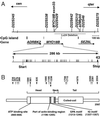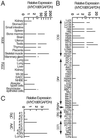MYO18B, a candidate tumor suppressor gene at chromosome 22q12.1, deleted, mutated, and methylated in human lung cancer
- PMID: 12209013
- PMCID: PMC129434
- DOI: 10.1073/pnas.192445899
MYO18B, a candidate tumor suppressor gene at chromosome 22q12.1, deleted, mutated, and methylated in human lung cancer
Abstract
Loss of heterozygosity on chromosome 22q has been detected in approximately 60% of advanced nonsmall cell lung carcinoma (NSCLC) as well as small cell lung carcinoma (SCLC), suggesting the presence of a tumor suppressor gene on 22q that is involved in lung cancer progression. Here, we isolated a myosin family gene, MYO18B, located at chromosome 22q12.1 and found that it is frequently deleted, mutated, and hypermethylated in lung cancers. Somatic MYO18B mutations were detected in 19% (14/75) of lung cancer cell lines and 13% (6/46) of primary lung cancers of both SCLC and NSCLC types. MYO18B expression was reduced in 88% (30/34) of NSCLC and 47% (8/17) of SCLC cell lines. Its expression was restored by treatment with 5-aza-2'-deoxycytidine in 11 of 14 cell lines with reduced MYO18B expression, and the promoter CpG island of the MYO18B gene was methylated in 17% (8/47) of lung cancer cell lines and 35% (14/40) of primary lung cancers. Furthermore, restoration of MYO18B expression in lung carcinoma cells suppressed anchorage-independent growth. These results indicate that the MYO18B gene is a strong candidate for a novel tumor suppressor gene whose inactivation is involved in lung cancer progression.
Figures




References
-
- Shiseki M., Kohno, T., Nishikawa, R., Sameshima, Y., Mizoguchi, H. & Yokota, J. (1994) Cancer Res. 54, 5643-5648. - PubMed
-
- Kawanishi M., Kohno, T., Otsuka, T., Adachi, J., Sone, S., Noguchi, M., Hirohashi, S. & Yokota, J. (1997) Carcinogenesis 18, 2057-2062. - PubMed
-
- Virmani A. K., Fong, K. M., Kodagoda, D., McIntire, D., Hung, J., Tonk, V., Minna, J. D. & Gazdar, A. F. (1998) Genes Chromosomes Cancer 21, 308-319. - PubMed
-
- Testa J. R., Siegfried, J. M., Liu, Z., Hunt, J. D., Feder, M. M., Litwin, S., Zhou, J. Y., Taguchi, T. & Keller, S. M. (1994) Genes Chromosomes Cancer 11, 178-194. - PubMed
-
- Mertens F., Johansson, B., Hoglund, M. & Mitelman, F. (1997) Cancer Res. 57, 2765-2780. - PubMed
Publication types
MeSH terms
Substances
Associated data
- Actions
- Actions
- Actions
- Actions
- Actions
- Actions
- Actions
- Actions
Grants and funding
LinkOut - more resources
Full Text Sources
Other Literature Sources
Medical
Molecular Biology Databases

